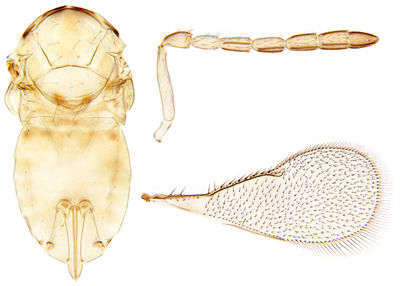Encarsia aferi Schmidt & Polaszek
Diagnosis
Female
Colour: head and mesosoma yellow except pronotum, anteromedial patch on mesoscutal midlobe, and propodeum partly brown. Gaster yellow, petiole and T1 with faint transverse brown band. Antenna yellow, apex brown. Fore wing hyaline. Legs yellow.
Morphology [measurements of holotype in square brackets]: stemmaticum with rugose surface sculpture. Antennal formula 1,1,3,3. Pedicel subequal to, or slightly longer than, F1 (1.00–1.13) [1.12]. F1 (1.71–1.92) [1.92] times as long as its maximum width, shorter than F2 (0.73–0.83) [0.83], and shorter than F3 (0.75–0.81) [0.81]. F2 subequal in length to F3. Flagellomeres with the following numbers of sensilla: F1: 0, F2: 2, F3: 2, F4: 3, F5: 3, F6: 3. Midlobe of mesoscutum with eight setae, arranged symmetrically. Scutellar sensilla widely separated, approximately five times the maximum width of a sensillum. Distance between anterior pair of scutellar setae subequal to distance between posterior pair. Fore wing 2.3 times as long as width of disc. Marginal fringe 0.20–0.21 [0.21] times as long as width of disc. Basal cell with five or six seta. Submarginal vein with two (or three) setae, marginal vein anteriorly with seven setae. Tarsal formula 5-5-5. Apical spur of midtibia slightly longer than half the length of the corresponding basitarsus (0.57–0.63) [0.63]. Tergites laterally with the following numbers of setae: T1: 0, T2: 1, T3: 1, T4: 3, T5: 3, T6: 3, T7 with four setae. Ovipositor slightly shorter than midtibia (0.85–0.91) [0.91] and 1.24–1.30 [1.30] times as long as clava. Third valvula 0.30–0.33 [0.32] times as long as second valvifer.
Male
Unknown
Species group placement
Encarsia inaron group.
Distribution
Australia: Queensland.
Hosts
Aleyrodidae: Bemisia afer (Priesner and Hosny).
Comments
Encarsia aferi resembles E. thoreauini but can be distinguished by the different wing shape and the setation of the fore wing being more scattered than in thoreauini. It is also similar to E. aleurochitonis Mercet but can be separated by the reticulate surface sculpture of the stemmaticum, whereas in E. aferi the sculpture is rugose. Also, E. aferi has a much longer fore wing marginal fringe which is about 0.2 times as long as the maximum width of disc, whereas in E. aleurochitonis it is less than 0.1 times.
References
Schmidt, S., Polaszek, A. (2007). The Australian species of Encarsia Förster (Hymenoptera, Chalcidoidea: Aphelinidae), parasitoids of whiteflies (Hemiptera, Sternorrhyncha: Aleyrodidae) and armoured scale insects (Hemiptera, Coccoidea: Diaspididae). Journal of Natural History 41(33-36): 2099-2265. doi
